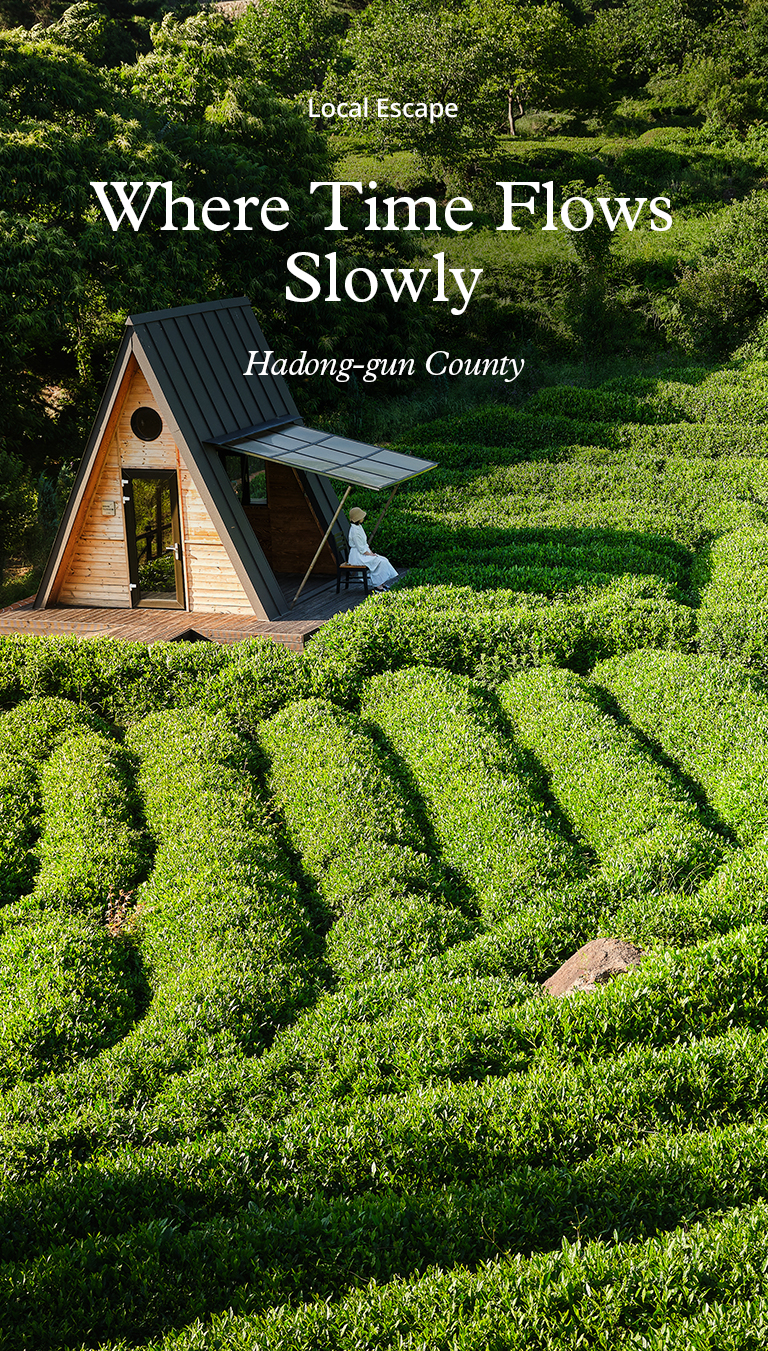
July marks the start of summer vacation, a time of restoring energy and wrapping up the first half of the year that was filled with new promises and challenges. We head for Hadong-gun County, land of tea and literature, to brew tea and appreciate its flavor and scent as a way to take a pause from life.
Writer. Hye Kyeong Sung
Drive south of Korea, winding through the hills of Jirisan Mountain towards Hadong-gun County. Just like its name that translates to “East of the Water,” Hadong is located east of the Seomjingang River on the downstream. Arriving in Hadong, visitors are greeted by the wide embrace of the Seomjingang River. The clear water from the mountain valley flows quietly into the river, reflecting the sky. The white sand of the riverbed, gentle curves of the sand dune and birds in the sky create a picturesque scenery.
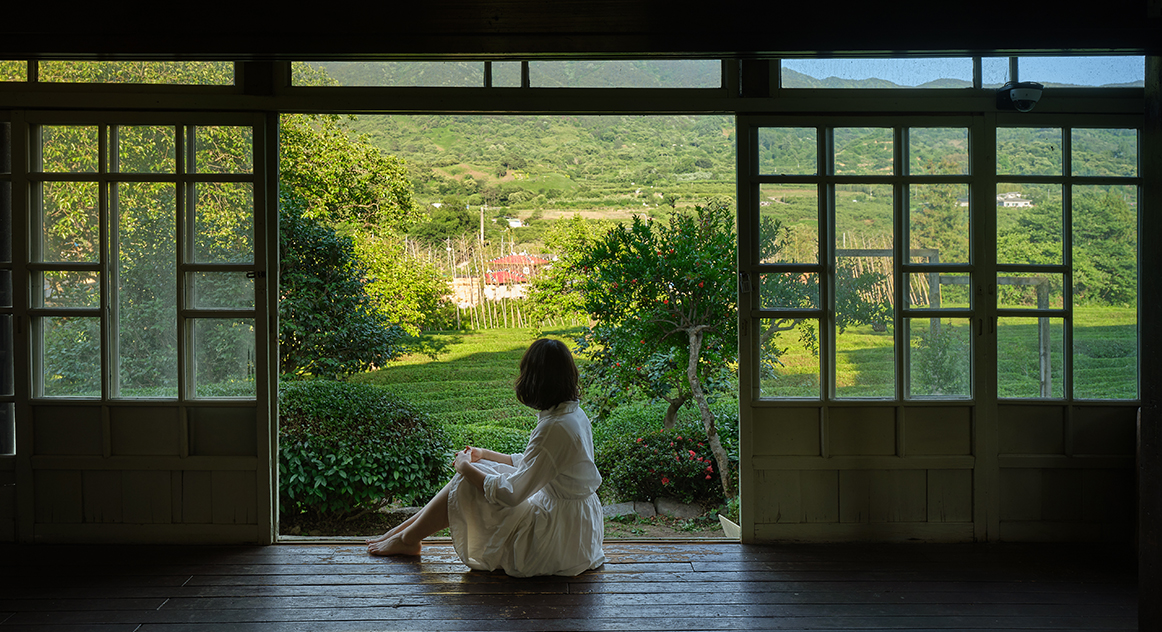 Maeam Tea Museum, an experiential museum offering tea-making experiences and tea culture education.
Maeam Tea Museum, an experiential museum offering tea-making experiences and tea culture education.
Continue along the Seomjingang River and one of its tributaries, Hwagaecheon Stream. Hadong is recognized as the birthplace of Korean green tea, where the first tea seed was planted in 823. The wild tea field at Ssanggyesa Temple is a proof of this old history, together with big and small private tea gardens dotted along the stream that leads to the temple. The foggy and humid mountainous landscape with significant daily temperature differences provides an ideal condition for cultivating tea.
Drive along the country road between a sea of green with rows of endless tea trees in the distance. Seeing this splendor of heart-filling contentment, visitors will find places where the sky, light and green shine exceptionally brighter. For a closer inspection, look for a tea garden road sign that says “The most beautiful tea garden designated by Hadong.” Most of the tea gardens are open to visitors with well-kept paths and resting areas.
Visitors to these establishments can enjoy tea from the garden shops while taking in the natural surroundings. Just select a packet of green tea from the wide selection, grab a tea set from the shop and find a spot in the garden. Wait for the tea leaves to brew in the hot water while immersing yourself in the tranquility of the tea fields, the green bushes gently swaying in the wind under the sun. The breathtaking green scenery, fragrant tea and a good book are right here for this small luxury. Taking in the sound of the wind and rustling of leaves, the bright shining tea leaves and blue sky, one could not possibly hope for a more perfect summer view.
After a restful tea time at the tea gardens, stop by one of the tea houses for a cultured tea experience led by a tea master. Intricate tea ware and utensils as well as a wide variety of tea from across the world are on display. During the demonstration, visitors can observe the tea master heat the tea ware and brew the tea once and also multiple times. You are offered a chance to savor the two types of tea and enjoy the difference. Except for the pleasant conversation and a fragrant cup of tea, everything else is washed away, leaving you only with renewed contentment.
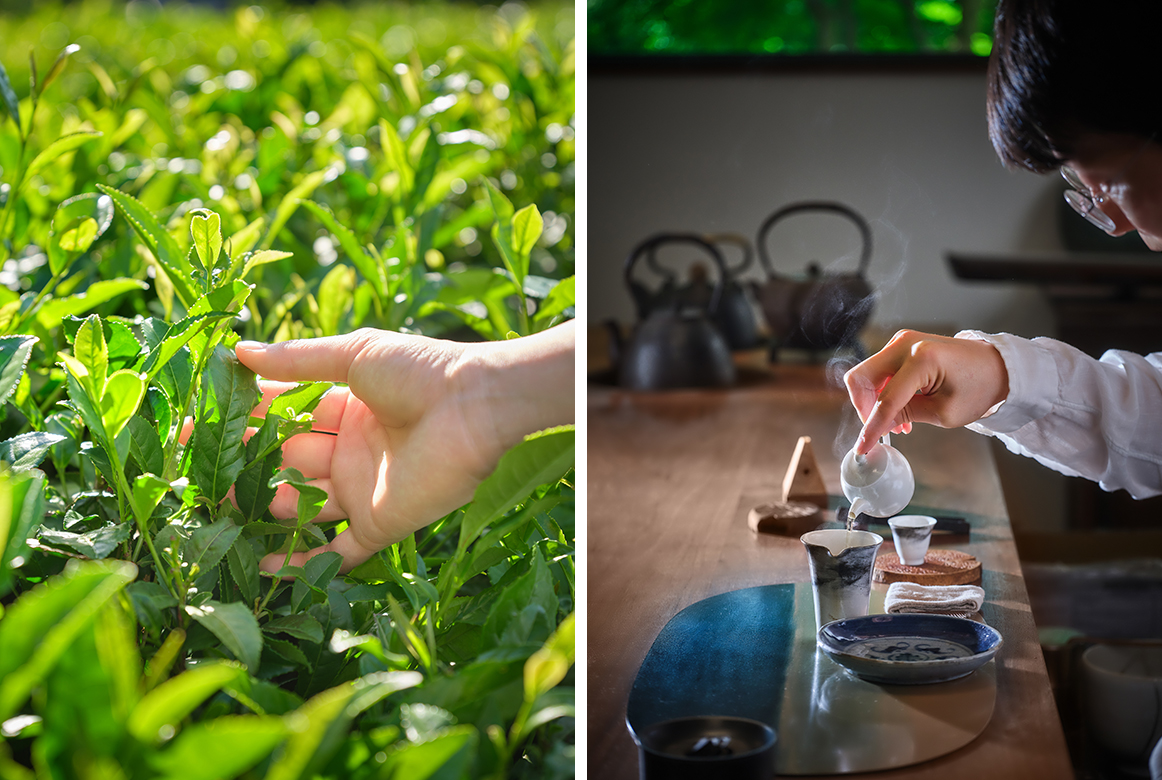 (Left) Tea farms in Hadong offer hands-on experiences such as tea leaf cultivation through early summer.
(Left) Tea farms in Hadong offer hands-on experiences such as tea leaf cultivation through early summer.
(Right) Hojunggeo, a specialized teahouse in Hadong
하동을 향해 차를 타고 가노라면 한국 남쪽의 큰 산맥인 지리산을 굽이 돌게 된다. 하동은 물의 동쪽이란 뜻의 지명대로 섬진강이라는 큰 강의 동쪽이자 하류에 있다. 하동에 들어서자마자 마주하는 섬진강의 품은 넉넉하다. 산속 계곡들의 맑은 물이 모여 하늘과 맞닿은 채 고요히 흐른다. 하얀 백사장, 완만한 모래톱과 새가 여유로운 풍경을 수놓는다.
섬진강과 그것의 지류인 화개천을 따라 이동한다. 하동은 한국 차의 첫 재배지로, 823년, 이 땅에 처음으로 차 종자가 심긴 곳이다. 쌍계사에는 그 역사를 증명하는 야생차 재배지가 있고, 그곳으로 이어지는 천 주변에는 크고 작은 개인 다원들이 밀집해 있다. 산간 지역이라 안개가 많이 끼고 다습해 일교차가 큰 지역이다. 차를 재배하기에 좋은 기후라고 한다.
차밭의 푸른 빛이 넘실거리는 국도를 차로 이동한다. 멀리 산자락 위로 차나무들이 줄지어 자라난다. 마음이 절로 흐뭇해지는 풍광이다. 하늘, 햇빛, 초록이 유독 빛나 보이는 곳들이 있다. 그 모습을 좀 더 자세히 눈에 담아두고 싶어, 하동군이 선정한 아름다운 다원이라는 표지판이 있는 차밭을 찾는다. 대개는 열린 다원으로 산책로를 잘 마련한 곳도 있고, 누구나 이용할 수 있도록 휴식 공간을 마련한 곳도 있다.
카페를 겸하는 다원에서 하동이 자랑하는 녹차를 고른 뒤, 다구를 한 아름 챙겨 목 좋은 곳에 자리를 잡는다. 뜨거운 물에 차를 우리고 기다린다. 차가 우러나오는 동안 차밭을 눈으로 음미한다. 바람이 불면 빼곡하고 푸릇한 잎들이 햇빛을 받으며 살랑인다. 풍경을 즐기고 그윽한 차향을 즐긴다. 책도 읽어보고, 풍경도 바라보며 갖는 호사스러운 시간이다. 바람 소리, 잎들이 부딪히며 사그락거리는 소리, 반짝이는 잎, 푸른 하늘을 보니 이보다도 완벽한 여름 풍경은 없을 것만 같다.
다원 외에도 차 전문가가 수 시간 동안 여러 차를 우려 주는 공간도 찾는다. 작고 정갈한 차 도구들, 한국뿐만 아니라 차로 유명한 나라에서 온 차들이 있다. 차 도구를 데우고, 찻잎을 우리는 과정을 지켜본다. 한 번 우린 차의 향과 여러 번 우린 차의 맛을 음미하며 비교한다. 간간히 나누는 즐거운 담소와 함께 오롯이 차에만 집중한다. 차와 나를 제외한 것들은 점차 지워내며 정화되는 듯, 단정해지는 기분을 만끽한다.
Hadong is also well known as a center of Korean literature. It is the backdrop of many significant works of modern Korean literature including “Toji” (”Land” in English) by Pak Kyongni, “Jirisan” by Lee Byeng-Ju, “Taebaeksanmaek” by Jo Jung-rae and “Song of the Sword” by Kim Hoon. Among these works, Pak Kyongni’s “Toji” is an epic masterpiece that was written over a period of 25 years set in Hadong. The novel chronicles Korea’s tumultuous history from the late Joseon period in 1897 to Korea’s liberation in 1945 following the lives of villagers of a traditional farming community. A most beloved book that has led to many film, television series, play and musical adaptations, visitors can see the setting of this story come alive in Pyeongsa-ri Village in Hadong.
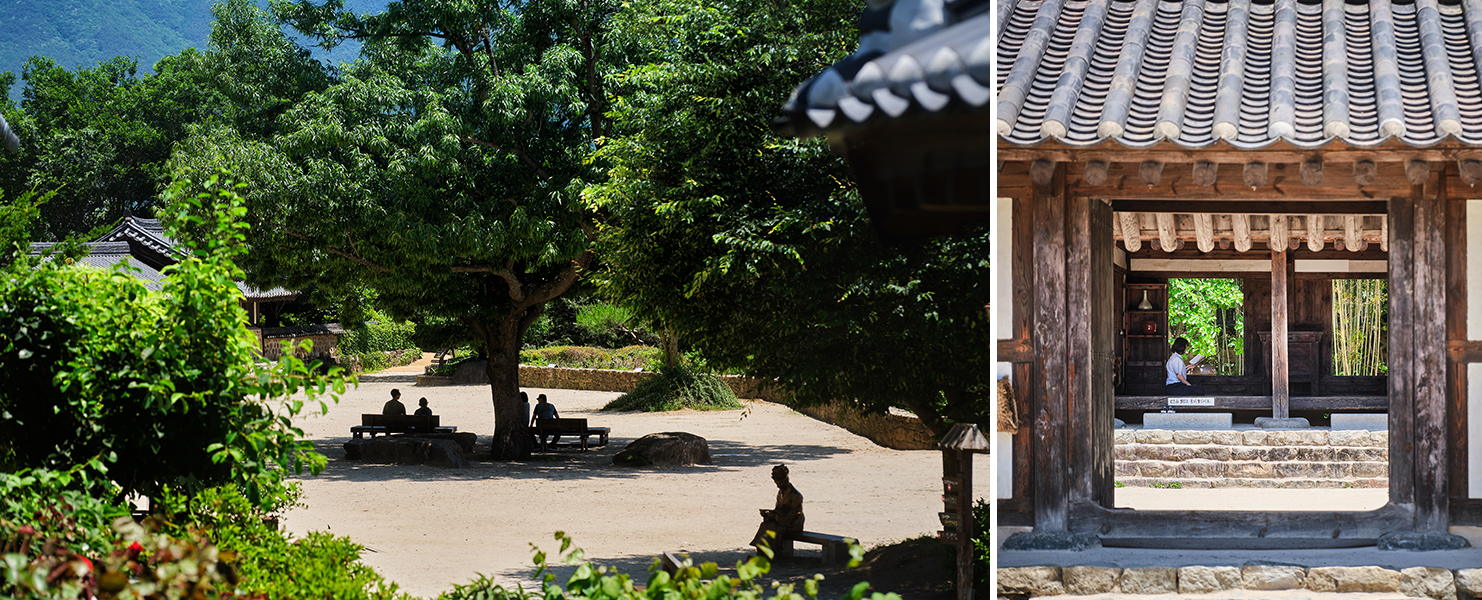 House of Choi Champan
House of Choi Champan
On the foothills of Jirisan sits a grand Hanok (Korean traditional house) called House of Choi Champan. The house, meticulously recreated according to the novel, is a fine example of traditional Hanok from the end of Joseon era. Leave your shoes at the entrance before stepping onto the wooden-floored hall to admire the rice fields stretched beyond the estate, or stroll along the quiet path lined with bamboo trees. As you listen to the sound of wind chimes, an elderly gentleman dressed handsomely in summer Hanbok (Korean traditional Clothing) comes to greet you like he has just stepped off the pages of the book. It is the honorary master of the House of Choi Champan, a staff of the estate who will write words of wisdom with traditional artistic brushstrokes for visitors upon request. It will surely make a meaningful keep-sake from your Hadong travels.
The occasional rooster’s crow and lowing of cows fill the air. They are coming from the filming location where the drama “Toji” was produced. Traditional thatched roof houses where the drama’s main characters lived and the sounds of animals add warmth to this realistic setting, enabling visitors to imagine stepping back in time into the story.
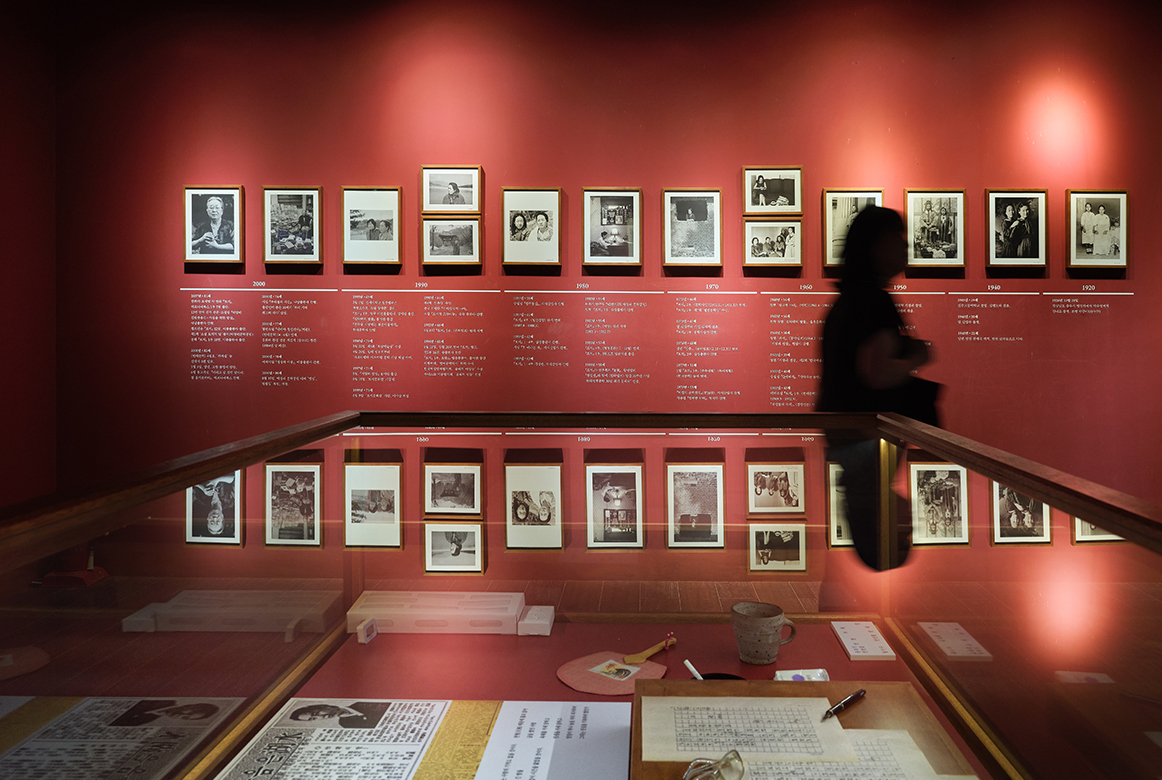 Exhibition at the Pak Kyongni Literature Museum
Exhibition at the Pak Kyongni Literature Museum
Across the street from the estate is a museum celebrating the life and literary accomplishments of Pak Kyongni. A statue of the author greets visitors at the entrance of the museum where Pak’s portrait, video, stationary and different printed editions of “Toji” are on display. Visitors are invited to sit and handwrite phrases from the novel or leave reviews of the exhibit. Taking a glance over the reviews, curious to know what people have gathered from this visit, a visitor says that someday he will read the novel “Toji” that takes place in this village.
As dusk falls, cross the Seomjingang River back to the other side. A local marsh clam known as jaecheop (freshwater marsh clam) in Korean thrive in these waters where the river meets the ocean. The aroma of savory jaecheop hangs in the air as you step into a restaurant by the river. The menu offers jaecheop fritters and raw jaecheop meat, but jaecheopguk (freshwater marsh clam soup) is a must. A bowl of this slightly sweet and salty jaecheop with rich soup is the perfect meal to wrap up your trip to Hadong. It was a day marked by a pause button in your hectic life, a time of wholesome solitude. As you leave Hadong, going back to your daily life, you make a silent promise that you will set aside time for yourself again just like you did here.
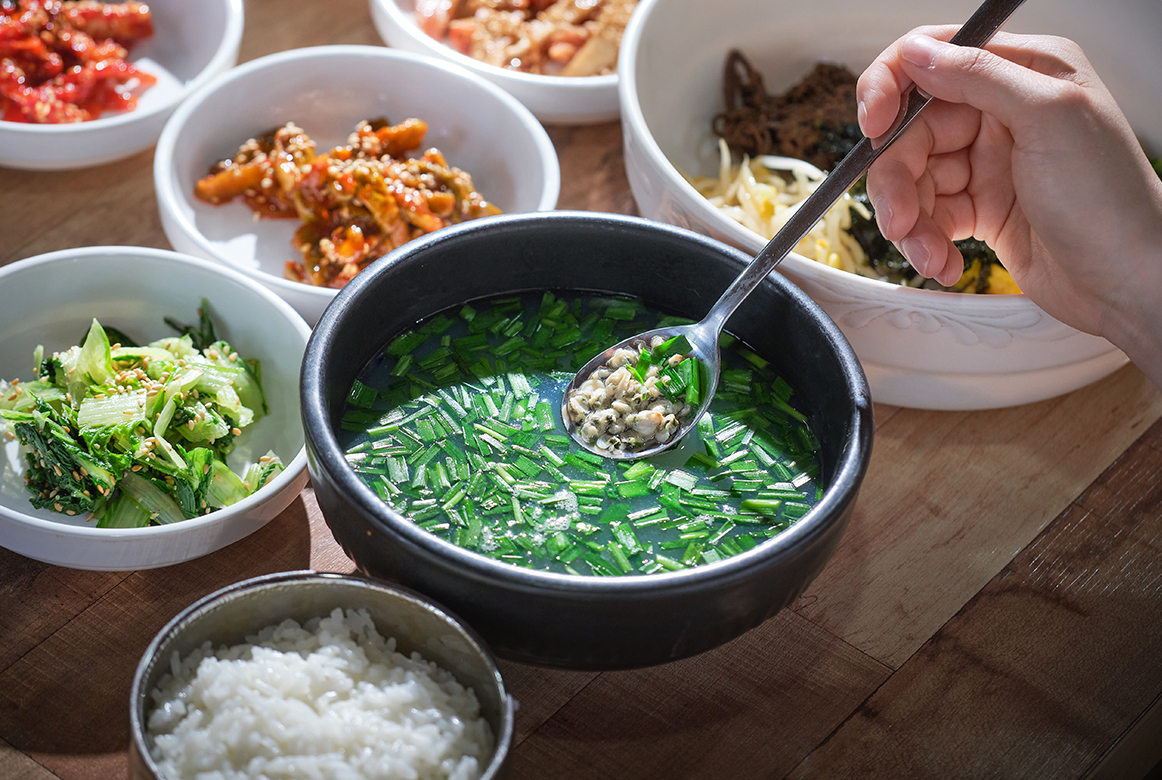 jaecheopguk (freshwater marsh clam soup) of Hadong
jaecheopguk (freshwater marsh clam soup) of Hadong
하동은 문학의 성지로도 유명하다. 박경리의 <토지> 이병주의 <지리산>, 조정래의 <태백산맥>, 김훈 <칼의 노래> 등 한국을 대표하는 근현대 문학의 배경지가 된 곳이다. 그 중, 박경리의 토지는 하동을 배경으로 약 25년간 집필된 대하소설이다. 구한말부터 해방까지 조선 후기의 고된 역사를 민중의 이야기로 풀어냈다. 영화, 드라마, 뮤지컬, 연극으로 각색될 만큼 큰 사랑을 받은 이 작품의 배경을 그대로 재현해 둔 곳이 하동 평사리에 있다.
야트막한 산 아래 으리으리한 한옥이 있다. 이곳의 이름은 최참판댁. <토지>의 최참판이 사는 곳을 재현해 둔 곳으로, 조선 후기 한옥을 잘 구현해 두었다. 신발을 벗고 널찍한 대청마루 위로 올라가 아래 멀리 펼쳐진 논밭을 보기도 하고, 대나무가 늘어진 산책로를 거닐어 본다. 들판 넘어 불어오는 바람이 풍경 종을 울리는 것을 바라보다 소설 속 인물이 튀어나온 듯 한복을 곱게 입은 어르신을 만났다. 최참판댁의 명예 참판이다. 최참판댁의 한편에 상주하는 직원으로, 요청하면 유려한 붓글씨로 가훈이나 덕담을 써준다. 하동에서의 기억을 절로 떠올리게 할 작품이다.
간간이 닭이 우는 소리나, 소가 우는 소리가 들린다. 아래에는 드라마 <토지>의 세트장에서다. 극 중 주요 인물들이 살던 초가집이 모여있고, 가축 소리가 들리는 그곳이 어쩐지 정겹다. <토지>의 안으로 들어왔다는 상상을 즐겨본다.
최참판댁 건너편에는 박경리 문학관이 있다. 박경리의 문학적 업적을 기리는 공간이다. 인사를 건네는 박경리 동상을 지나쳐 전시장에 들어서면, 그의 지난날들이 펼쳐진다. 초상화, 영상, 그의 필기구, 옷, 안경, 출판사별 <토지>의 표지 등등. 원고지에 토지를 필사하거나 전시 감상평을 남기는 공간도 있다. 사람들은 저마다 이곳서 무엇을 얻어갔을까, 그들의 의견을 살짝 훔쳐본다. <토지>가 이곳을 배경으로 한 작품이니, 언젠가 읽어보겠다는 평도 그 뒤로 남긴다.
해가 저물 때쯤 다시 섬진강을 지난다. 바닷물과 민물이 만나는 이곳에 재첩이 많이 난다고 했다. 강에 면한 식당에 들어서니 재첩이 품은 신선한 내음이 은은하게 어려있다. 재첩살을 발라 만든 전이나 회도 있지만, 재첩을 끓여낸 국을 주문한다. 조개종이 가진 은근한 단맛, 바다의 맛이 나지만 깔끔하다. 뽀얀 국물에 몇 번이고 속을 적시며 하동에서의 시간을 곱씹는다. 할 일에 쫓겨 공백 한번 없이 조급히 흘러가던 날들에, 쉼표가 찍혔다. 오직 혼자만을 위한 시간의 힘을 느낀다. 일상으로 돌아가겠지만, 이곳에서의 시간처럼 자신을 위한 순간을 갖자고 다짐한다.